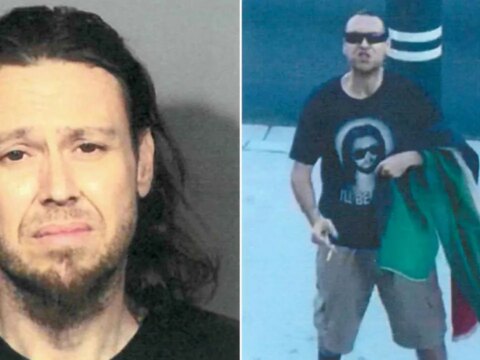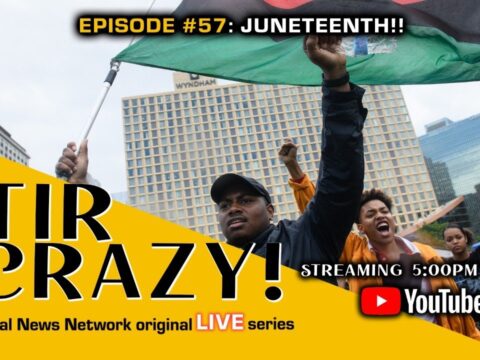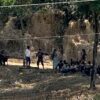DAKAR, Senegal (AP) — Women slain with babies wrapped against their bodies, lifeless children intertwined together, a 2-month-old face-up on the ground with puppies crawling on his tiny frame. The scenes were horrifying, but the 32-year-old farmer felt he had to document them, as proof of the carnage in his central Burkina Faso village.More than a dozen relatives were killed Nov. 5 when security forces attacked with mounted pickup trucks, guns and drones, he told The Associated Press on condition of anonymity, for fear of retaliation. He said he hid for hours in a neighbor’s compound and took a series of photos before fleeing the next morning.PRIVATE PLANE CRASH KILLS 5, INJURES 2 IN BURKINA FASODozens more were killed that day in Zaongo village, according to his account and that of two other survivors, as well as a U.N. report citing government figures. The images the man sent AP and the interviews with the three survivors are rare firsthand accounts amid a stark increase in civilian killings by Burkina Faso’s security forces as the junta struggles to beat back a growing jihadi insurgency and attacks citizens under the guise of counterterrorism.Most attacks — including the slaying of children by soldiers at a military base last year, uncovered in an AP investigation — go unpunished and unreported in a nation run by a repressive leadership that silences perceived dissidents. A mural is seen in Ouagadougou, Burkina Faso, Wednesday March 1, 2023. Three survivors of an attack in Zaongo, central Burkina Faso, told AP that dozens of people were killed in their village on Nov. 5 when security forces attacked. One of the survivors, a 32-year-old farmer, said he photographed the horrific scenes of bodies as proof of the carnage before fleeing. (AP Photo)More than 20,000 people have been killed since jihadi violence linked to al-Qaida and the Islamic State group first hit the West African nation nine years ago, according to the Armed Conflict Location and Event Data Project, a U.S.-based nonprofit. The fighting has divided a once peaceful population, blockaded dozens of cities and led to two military coups.Civilian deaths at the hands of security forces increased by 70% from 2022 to 2023 — to 735 people killed from 430, ACLED figures show.Burkina Faso’s government spokesman didn’t respond to requests for comment about the Nov. 5 attack. Previously, officials have denied killing civilians and said jihadis often disguise themselves as soldiers.The three survivors told AP they’re certain the men were security forces, not jihadis. They describe them wearing military uniforms, one with a Burkina Faso flag fastened to him as he tried to warn a group of civilians that anyone found alive would be killed. The farmer saw a helicopter flying toward the village in the attack’s aftermath — those are used solely by the military, not insurgents.The United Nations urged the government to conduct an independent and transparent investigation into the attack, hold those responsible accountable, and compensate victims and families, said Seif Magango, spokesperson for the U.N. Human Rights Office.Burkina Faso’s prosecutor’s office said it opened an investigation, but four months later, survivors said they’ve had no news.”THEY MASSACRED THEM”It was early morning when the farmer heard gunshots in the distance. He was cultivating land a few miles from home with his father, he said, and they returned to the village to wait it out.Violence in Namentenga province is frequent, locals said — it’s common to hear shootings and see soldiers on patrol.But this Sunday was different.About 3 p.m., the farmer said, hundreds of men — most in military fatigues — stormed through on motorbikes and trucks and started indiscriminately killing people.He hid at the neighbor’s home, he said, and after hours of gunshots, the man with the Burkina Faso flag entered, warning people to stay out of sight.”The soldier told us that his colleagues were in the other compound,” the farmer said. “He said he didn’t want to hurt us, but if the others realized we were still alive, they’d kill us.”When the guns stopped that evening, he said, he left the compound and saw Zaongo littered with dead and injured men, women and children. Among them were his father, two brothers, a sister and her four children.His uncle’s body lay under a pile of several children. His 63-year-old father was by the door of their house.”These people sought shelter in their huts, but they massacred them,” the farmer said.THE JUNTA TODAYIt’s unclear what prompted the attack, but locals said most times, security forces think villagers are working with the extremists.Since seizing power in the second coup in September 2022, the junta led by Capt. Ibrahim Traoré has threatened rights groups and journalists and carried out attacks against civilians — potential war crimes under international law.Military drone strikes late last year claiming to target Islamic fighters killed at least 60 people at two markets and a funeral in Burkina Faso and neighboring Mali, according to Human Rights Watch.The junta is on a war footing as it tries to beat back the jihadis, who’ve overtaken more than half the country, according to conflict analysts and Sahel region experts. It’s using a new general mobilization law to expand its crackdown and force people into combat.The junta is distancing itself from regional and Western nations that don’t agree with its approach. This year, it left the West African regional economic bloc known as ECOWAS and created an alliance with Mali and Niger, also run by military juntas battling jihadi insurgencies.The junta severed military ties with former colonial ruler France. Officials have welcomed several dozen Russians tasked in part with keeping the junta in power, according to several conflict experts and a diplomat who spoke on condition of anonymity because he wasn’t authorized to discuss the matter.In November, days after the Zaongo massacre, 50 Russians arrived in Burkina Faso to protect the junta, influence public opinion and provide security services, said Lou Osborn with All Eyes on Wagner, a project focusing on the Russian mercenary group, which operates in a handful of African countries.While the Wagner Group’s future has been uncertain since leader Yevgeny Prigozhin died in a suspicious plane crash last year, its presence in Burkina Faso is part of the group’s new and more visible phase of influence, Osborn said. A pro-Russian association called the Africa Initiative has been established and is staffed with former Prigozhin employees, she said.Its goal, initiative president Soumaila Azenwo Ayo told AP, is promoting Russian and Burkina Faso culture and language, in part through its new radio program, “Russian Hour.”Africa is key to Russia politically and economically as it seeks allies amid its war in Ukraine. But Wagner mercenaries have been accused by rights groups and civilians of committing human rights atrocities in the countries where it operates, including the killing of 300 people at a Mali village in 2022. An increased Burkina Faso presence would bring fear of even more civilian deaths.The United States said it has cut and suspended assistance to Burkina Faso’s military but still supplies nonlethal equipment to civilian security forces such as the national police. In January, it delivered nearly 100 bikes and pickups.In a statement, the State Department said it has provided $16 million in “counterterrorism capacity building assistance” to Burkina Faso since 2022.”We are not aware of any diversion of misuse of recent equipment,” it said. “We take allegations seriously and will continue to monitor and evaluate use of our security assistance.”Some analysts said continued U.S. aid sends the wrong message.”Other countries around the world are seeing and watching and saying to themselves, ‘I can also jail all of my opponents, kill civilians under the guise of counterterrorism efforts and also play friendship with Russia, China — and the US will still give me all the toys I’ve asked for,’” said Aneliese Bernard, a former State Department official specializing in African affairs who runs a risk advisory group.CIVILIANS IN THE MIDDLEDuring the Nov. 5 attack, men in military uniforms speaking French and local language Moore called for all men to leave their houses, a 45-year-old mother told AP.Peering through the window of the home where she hid, she said, she saw relatives being killed — more than 15 in all.She said she was spotted by a soldier, who motioned for her to lie down and stay silent. The men dressed, looked and sounded like the soldiers who regularly pass through the village inspecting people’s documents, she said.The third survivor who spoke to AP, a 55-year-old man from Zaongo, said villagers had been accused of working with the jihadis because they refused to join tens of thousands of volunteer fighters serving alongside Burkina Faso’s military.Recruiting is part of the junta’s strategy, but residents said this has only contributed to civilian killings as volunteers round up anyone they suspect of ties to the extremists. It also provokes jihadis to attack communities with volunteers, they said.Civilians are increasingly caught in the middle as violence intensifies. More than 2 million have been displaced and tens of thousands face severe hunger, according to the U.N. The insecurity makes it hard for aid groups to get assistance to those who need it.At least 74 civilians were killed in connection with a weekslong convoy carrying food and aid in December, according to ACLED. They were killed by both the military and jihadis, two aid workers told AP on condition of anonymity because they weren’t authorized to speak about the matter. One worker said the jihadis accused the civilians of providing information to the convoy’s armed escort.An internal report for aid workers seen by AP said soldiers escorting the food supplies “fired on suspected accomplices” of jihadi-affiliated fighters.”WE’RE FRIGHTENED”Four months after the attack, survivors fear that bodies still lie on the ground rotting in Zaongo, now occupied by jihadis. Some relatives were able to return about a week after the deaths, but there were too many bodies and not enough time to bury them all, they said. They’ve been unable to get back since.CLICK HERE TO GET THE FOX NEWS APPIt’s still unclear how many people were killed – reports from survivors, the U.N. and aid groups vary, from 70 to more than 200.Survivors are displaced in different parts of the country. They’re calling on the government to hold the killers accountable while living in fear that it could happen again.”We never thought that so many people could be killed at once,” said the surviving woman who spoke to AP.”When a door slams or a child shouts, we’re frightened. If we go back there, we’ll just die.”
Breaking News
2024-10-27 A man who abused up to 3,500 girls online has been sentenced for crimes including manslaughter
2024-10-27 Rear Admiral Claims Government COVERED UP Alien Contact. We’ve Talked with ALIENS????
2024-10-27 BREAKING: UN Sec Council Passes Gaza Aid, US Sits Out; Trump Audio EXPOSES Pressure On MI Officials
2024-10-27 Missing Juvenile Aamina Turner from the 12th District – Blotter
2024-10-27 Missing Endangered Person Ivelisse Lugo from the 2nd District – Blotter
Static News
500k views later The FLORIDA...
phillynews215 2021-04-27 50 Comments on Body Cam: Officer Fatal Shooting Man with a Sword – Pomona Police March 30- 2020
#officerinvolvedshooting #policeshooting #Pomona Policedepartment Please...
phillynews215 2021-04-27 50 Comments on Bodycam Shows Deputies Shooting Armed Suspect in Greenville, South Carolina
** (Disclaimer: This video content...
Video brought to you by...
Rafael Nieves 2024-10-27 0 Comment on A man who abused up to 3,500 girls online has been sentenced for crimes including manslaughter
A "relentless and cruel" online...
Rafael Nieves 2024-10-27 38 Comments on Rear Admiral Claims Government COVERED UP Alien Contact. We’ve Talked with ALIENS????
Robby Soave and Briahna Joy...
Rafael Nieves 2024-10-27 0 Comment on BREAKING: UN Sec Council Passes Gaza Aid, US Sits Out; Trump Audio EXPOSES Pressure On MI Officials
The Hill’s Kevin Cirilli recaps...
Rafael Nieves 2024-10-27 0 Comment on Missing Juvenile Aamina Turner from the 12th District – Blotter
The Philadelphia Police Department is...
Rafael Nieves 2024-10-27 0 Comment on Missing Endangered Person Ivelisse Lugo from the 2nd District – Blotter
The Philadelphia Police Department is...
phillynews215 2024-02-15 Comments Off on Okinawa vehicle roll incident occurs at same time ‘mass casualty’ drill expected
Marines injured in Japan rollover...
phillynews215 2024-02-08 Comments Off on 340 Burmese troops fled to Bangladesh following rebel skirmish, country says
About 340 Burmese security forces,...
phillynews215 2022-07-23 29 Comments on FEELINGS POLICE FOOL GETS WRECKED !! – VERMONT – First Amendment Audit – Amagansett Press
FEELINGS POLICE FOOL GETS WRECKED...
Get entered to win our...
phillynews215 2023-10-30 Comments Off on The Chris Hedges Report: Julian Assange’s father, John Shipton, speaks out
Julian Assange has spent over...
Proudly powered by ANGELHOUSE 2009 - 2024 | ALL YOUTUBE VIDEOS IS A REGISTERED TRADEMARK OF GOOGLE INC. | THE YOUTUBE CHANNELS AND BLOG FEEDS IS MANAGED BY THE RIGHTFUL OWNERS/CREATORS HOSTING BY PHILLYFINESTSERVERSTATS INC. ALL RIGHTS RESERVED



















